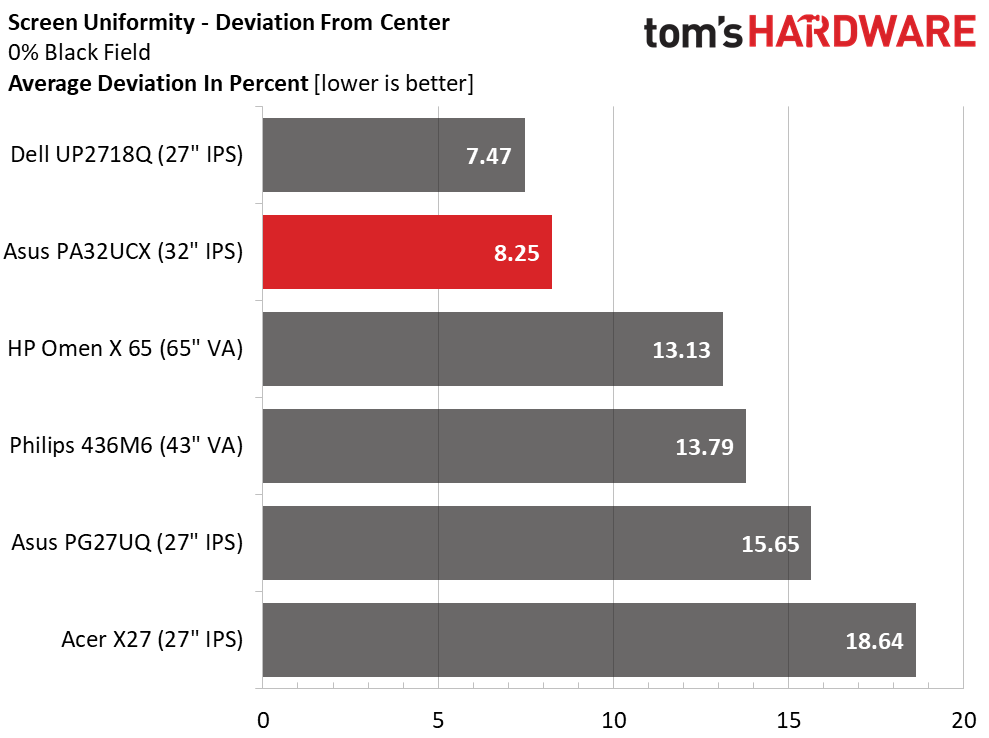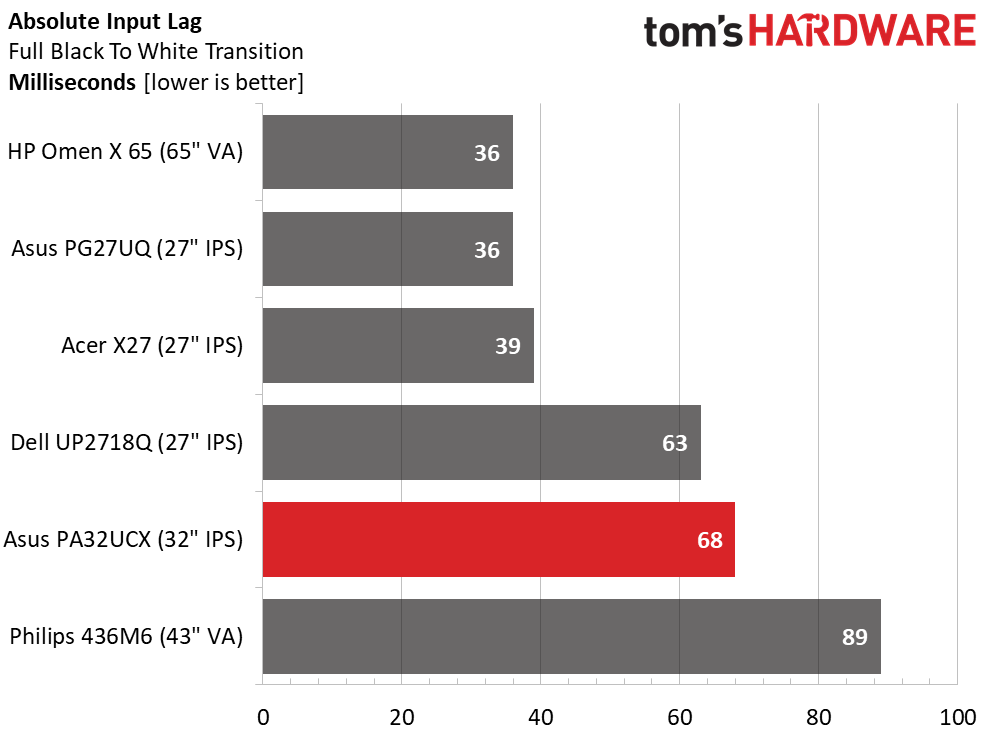Why you can trust Tom's Hardware
Viewing Angles

The PA32UCX uses an AHVA (advanced hyper viewing angle) IPS panel. The AHVA is for improving off-axis image quality, and AHVA IPS is a little better than typical IPS displays. However, you can still see a red color shift and a slight reduction in brightness at 45 degrees to the sides. This isn’t a big deal when considering a screen of this size. Three people can easily sit within a 90-degree viewing cone and share the PA32UCX. From the top, you can see a shift to blue and a brightness reduction of around 40%.
Screen Uniformity
To learn how we measure screen uniformity, click here.

The PA32UCX includes a uniformity compensation feature, but it was completely unnecessary with our review unit. There was no hint of bleed or glow, even in a completely dark room. Turning the compensation on increased the black level slightly; although, that was mitigated by the zone dimming.
Pixel Response and Input Lag
Click here to read up on our pixel response and input lag testing procedures.


To observe panel response, we shoot 1,000 frames per second (fps) video that allows us to watch the screen refresh by the millisecond. Most panels refresh in a single sweep from top to bottom, but the PA32UCX refreshes in four quadrants sequentially. This produces varying response times depending on the content’s sync to the panel’s refresh cycle. During gameplay, adaptive sync prevented frame tears, but fast gaming mouse movements produced some motion blur. Input lag was commensurate with most 60Hz screens we’ve tested, so we’d be happy to play casual games on it. You won’t get the ESP-level response of a 144Hz or 240Hz display, but the PA32UCX is adequate for blowing off a bit of steam after work.
MORE: Best Gaming Monitors
MORE: How We Test Monitors
Get Tom's Hardware's best news and in-depth reviews, straight to your inbox.
MORE: All Monitor Content
Current page: Viewing Angles, Uniformity, Response and Lag
Prev Page HDR Performance Next Page Conclusion
Christian Eberle is a Contributing Editor for Tom's Hardware US. He's a veteran reviewer of A/V equipment, specializing in monitors. Christian began his obsession with tech when he built his first PC in 1991, a 286 running DOS 3.0 at a blazing 12MHz. In 2006, he undertook training from the Imaging Science Foundation in video calibration and testing and thus started a passion for precise imaging that persists to this day. He is also a professional musician with a degree from the New England Conservatory as a classical bassoonist which he used to good effect as a performer with the West Point Army Band from 1987 to 2013. He enjoys watching movies and listening to high-end audio in his custom-built home theater and can be seen riding trails near his home on a race-ready ICE VTX recumbent trike. Christian enjoys the endless summer in Florida where he lives with his wife and Chihuahua and plays with orchestras around the state.
-
TheDane I know it is specified (in a smaller font below the title) but I'd prefer if you didn't use the term "mini-LED 4K HDR monitor" in the main title as this isn't a new type of panel, just an LCD panel with more zones. It confuses some people (like those who don't know that LED display are also just LCD panels with another type of backlighting).Reply -
JamesSneed ReplyTheDane said:I know it is specified (in a smaller font below the title) but I'd prefer if you didn't use the term "mini-LED 4K HDR monitor" in the main title as this isn't a new type of panel, just an LCD panel with more zones. It confuses some people (like those who don't know that LED display are also just LCD panels with another type of backlighting).
I could see that. Something like "4K HDR monitor with mini-LED backlight" would be much more forthcoming and less confusing imo. -
jasonelmore Oh wow, this thing is 4 grand. I'd love to see this technology come to Asus's Gsync line.Reply -
strongdc I'd like to see this go against Apple's new Pro Display. That also uses mini-LEDs and beats it in every spec.Reply -
TheDane 1400 zones vs 576 zone - no not in all metrics.Reply
I'll wait for the microLED TVs/monitors, after using OLED TVs for some time I just cannot see myself use LCD panels again. And microLED looks to have all the benefits of OLED (per-pixel-light) and no potential issues with retention (though my OLED TV still looks fine after 2 years of daily use). -
setx Those on screen controls... are pure cancer as usual. Even with top level hardware they don't bother to make them convenient to use.Reply
After using NEC advanced mode it feels like going from IPS to TN panel. -
cryoburner Reply
I agree, when I first clicked the article, I thought it was going to be a review for a MicroLED screen with individual LEDs making up each pixel element, but quickly discovered it was just another IPS screen, albeit with somewhat more local dimming zones for HDR. Meh. A 24x48 array of backlight LEDs on a 32" screen isn't exactly what I would call "mini".TheDane said:I know it is specified (in a smaller font below the title) but I'd prefer if you didn't use the term "mini-LED 4K HDR monitor" in the main title as this isn't a new type of panel, just an LCD panel with more zones.
I guess MicroLED is still a couple years or so away from mass production though, and will probably only appear at low pixel densities initially, like for big-screen TVs. It will probably be a number of years before we see a 32" 4K MicroLED screen. -
mohammed2006 toms hardware should have included sony BVM-HX310. to see how close it get to it. i need to upgrade my dell UP2718Q i am thinking ether asus or apple . please do asus vs apple and add Sony BVM-HX310.Reply -
jonpais Does the Asus require an i/o converter to use as an HDR reference grading monitor with a Mac?Reply -
crimsonfilms Replymohammed2006 said:toms hardware should have included sony BVM-HX310. to see how close it get to it. i need to upgrade my dell UP2718Q i am thinking ether asus or apple . please do asus vs apple and add Sony BVM-HX310.
What?
The BMV-HX310 is $32K discounted. It does not even occupy the same market space.